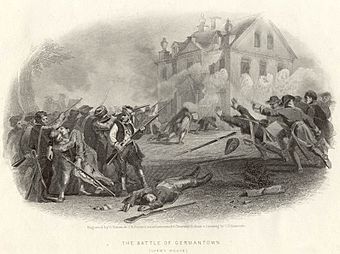Colonial Germantown Historic District facts for kids
|
Colonial Germantown Historic District
|
|
 |
|
| Lua error in Module:Location_map at line 420: attempt to index field 'wikibase' (a nil value). | |
| Location | Both sides of Germantown Avenue, between Windrim Avenue and Sharpnack Street Philadelphia, Pennsylvania |
|---|---|
| Area | 113 acres (46 ha) |
| Built | 1683 |
| Architect | Multiple |
| Architectural style | Colonial, Georgian, Federal |
| NRHP reference No. | 66000678 |
Quick facts for kids Significant dates |
|
| Added to NRHP | October 15, 1966 |
| Designated NHLD | June 23, 1965 |
The Colonial Germantown Historic District is a special area in Philadelphia, Pennsylvania. It's located in the Germantown and Mount Airy neighborhoods. This historic district stretches along both sides of Germantown Avenue.
This important road used to be an old Native American path. It started near the Delaware River and went through Germantown, about 6 miles northwest of downtown Philadelphia, all the way to Pottstown. The first settlers came to Germantown in 1683. They were Nederlanders and Germans. They were invited by William Penn and led by Francis Daniel Pastorius. These settlers were looking for a place where they could practice their religion freely.
Germantown became a very important place for new ideas in religion, printing, and education. It played a big role in early American history.
Contents
Important Moments in Germantown's History
Germantown has a rich past with many key events:
- August 16, 1683: Francis Daniel Pastorius arrived in Philadelphia.
- October 25, 1683: Land was divided among Pastorius's followers, and the settlement began.
- 1688: The first American anti-slavery protest was published here. This was a very early call for freedom.
- 1690: The first paper mill in America was built near Germantown. This helped with printing.
- 1705: Possibly the first oil portrait in America was painted by Christopher Witt in Germantown.
- 1708: The first Mennonite Meetinghouse in America was built.
- 1719: The first Dunkards arrived in America, settling in Germantown.
- 1743: The first Bible printed in America in any European language (German) was printed by Christoph Sauer.
- 1760: Germantown Academy, an important school, was founded.
- October 4, 1777: The famous Battle of Germantown took place during the American Revolutionary War.
- 1793: During the Philadelphia Yellow Fever Epidemic, President Washington and his team moved to Germantown to stay safe.
- 1794: President Washington spent two months in Germantown to avoid the summer heat in Philadelphia.
- July 20, 1825: General Lafayette, a hero of the American Revolution, visited Germantown.
- June 6, 1832: A railroad line from Philadelphia to Germantown opened, making travel easier.
A Special Historic Place
The Colonial Germantown Historic District was officially recognized as a National Historic Landmark in 1965. It was then added to the National Register of Historic Places in 1966. These designations mean the area is very important to the history of the United States.
The district first covered Germantown Avenue from the 4500 to 6600 blocks. In 1987, it grew even larger, extending north to the 7600 block. Today, the district includes 579 properties. Most of these, 514, are considered "contributing" properties. This means they add to the historical importance of the district.
The northwest Philadelphia area, sometimes called "Freedom's Backyard," has many historic places. It has 11 historic districts and 58 other important properties listed on the National Register of Historic Places. You can also find eight state historical markers along Germantown Avenue, telling stories of the past.
Famous Buildings in the District
Many historic buildings are part of the Colonial Germantown Historic District. Here are a few notable ones:
- Loudoun Mansion (4650 Germantown Ave.): Built in 1801, this beautiful home shows the Federal style of architecture.
- Mehl House (4821 Germantown Ave.): This stone house dates back to 1744. It's a great example of early American building.
- Lower Burial Ground (4901–21 Germantown Ave.): Established in 1692, this is now called Hood Cemetery. It has a grand entry gate designed in 1849.
- Grumblethorpe (5267 Germantown Ave.): Built in 1744, this house was owned by John Wister. It was an important spot during the Battle of Germantown.
- Germantown Friends School and Meeting House (5400 Germantown Ave.): The Quaker meeting was founded here in 1690. The current meeting house was built in 1869, and the school started in 1845.
- Germantown White House (Deshler-Morris House) (5442 Germantown Ave.): Built in 1772, this house served as the headquarters for British General Sir William Howe during the Battle of Germantown. Later, President George Washington lived here temporarily in 1793 and 1794 to escape yellow fever and the summer heat in Philadelphia.
- John Fromberger House (5501 Germantown Ave.): Built in 1796, this building now houses the Germantown Historical Society.
- Wyck House (6026 Germantown Ave.): Part of this house dates back to 1690, making it one of the oldest in the district. It was remodeled in 1824.
- Mennonite Meetinghouse (6119 Germantown Ave.): Built in 1770, this was the first Mennonite church in America, with the congregation starting in 1688.
- John Johnson House (6306 Germantown Ave.): Built in 1768, this house was a stop on the Underground Railroad, helping enslaved people find freedom.
- Concord School House (6309 Germantown Ave.): This stone schoolhouse was built in 1775.
- Upper Burial Ground (6311–17 Germantown Ave.): This burial ground was established in 1693.
- Cliveden (6401 Germantown Ave.): Built between 1763 and 1767, this was the estate of Benjamin Chew. It was a major site during the Battle of Germantown.
- Upsala (6430 Germantown Ave.): This house, built in 1798, is a good example of the Federal style.
- Church of the Brethren (6611 Germantown Ave.): Built in 1770, this was the first Church of the Brethren (Dunkards) in America.
- Beggarstown School (6669 Germantown Ave.): This historic school building dates back to 1740.
Images for kids














































